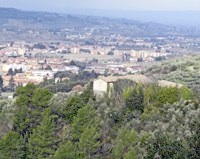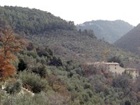


Eremo di Sant’ Elisabetta
from the Giro dei Condotti
According to the Statutes of 1347, the Eremo di San Leonardo marked the northern boundary of the hermitage of Monteluco, from which women were excluded. However, a number of women lived in hermitages on the lower slopes, beyond San Leonardo, probably from a very early date. At around the end of the 13th century, they were mostly forced to adopt one of the recognised religious rules and accept enclosure. All trace of the resulting nunneries has since disappeared, with the exception of the Eremo di Sant’ Elisabetta (see below).
Others are known from surviving documentation:
-
✴Santa Chiara di Colpetrosa (1293)
-
In 1293, Bishop Gerardo authorised a number of women here to form a nunnery on land donated by the hermits of Monteluco. He imposed the Augustinian Rule o the nuns,despite the fact that their nunnery was dedicated to the Franciscan St Clare. He decreed that similar nunneries should not be built nearby, a stipulation that was honoured in the breach. Cardinal Giacomo Colonna approved this foundation in 1294. In 1296, the Commune gave the nuns the privilege of cutting wood on Monteluco and of abstracting water from the nearby aqueduct. Cardinal Napoleone Orsini took the nunnery into his protection in 1302. The nunnery was closed and the nuns moved to Santa Caterina de Collefloreto on Colle Ciciano in 1371.
-
✴Sant’ Agnese “prope Spoleto” (13th century)
-
This nunnery is documented in 1296, when the Commune gave the nuns the privilege of cutting wood on Monteluco. This suggests that it was on or close to the mountain. No other record of it survives.
-
✴Santa Maria Maddalena di Monteluco (1295)
-
In 1295, Bishop Francesco conceded privileges to the nuns here, who followed the Augustinian Rule. In 1300, Cardinal Napoleone Orsini granted indulgences to those visiting the church on the first Sunday of each month. The nunnery was closed and the nuns moved to Santa Maria della Stella in 1443.
-
✴Santa Maria della Misercordia “prope Spoleto” (1294)
-
In 1294, at the request of Cardinal Giacomo Colonna, Bishop Gerardo authorised Sister Mattea and her companions to live as Franciscan tertiaries and to construct an oratory at the foot of Monteluco. In 1297, Bishop Francesco conceded indulgences to those visiting the nunnery here on specified feast days. In 1300, by which time the community had accepted the Augustinian Rule, Cardinal Napoleone Orsini granted further indulgences. He took the nunnery under his protection in 1303. It closed in 1353 and the nuns moved to San Ponziano.
-
✴San Bartolomeo di Monteluco
-
This nunnery is mentioned in the Legend of St Clare of Montefalco.
Eremo di Sant’ Elisabetta (13th century)

It contracted further in the following two decades and an unsuccessful attempt was made to transfer the remaining nuns to Santa Maria della Stella in 1411. It absorbed the nunnery of Sant’ Illuminata de Corvellone on Colle Ciciano in 1446. Following the intervention of two popes, Eugene IV and Nicholas V, the nunnery was finally closed and the nuns moved to Santa Maria della Stella in 1447.
[The nearby Santa Maria inter Angelos is known locally as “Sant’ Elisabetta”, and it might be that some of the nuns also moved there.]
The hermitage here was subsequently used as a farm, but it is now derelict.

